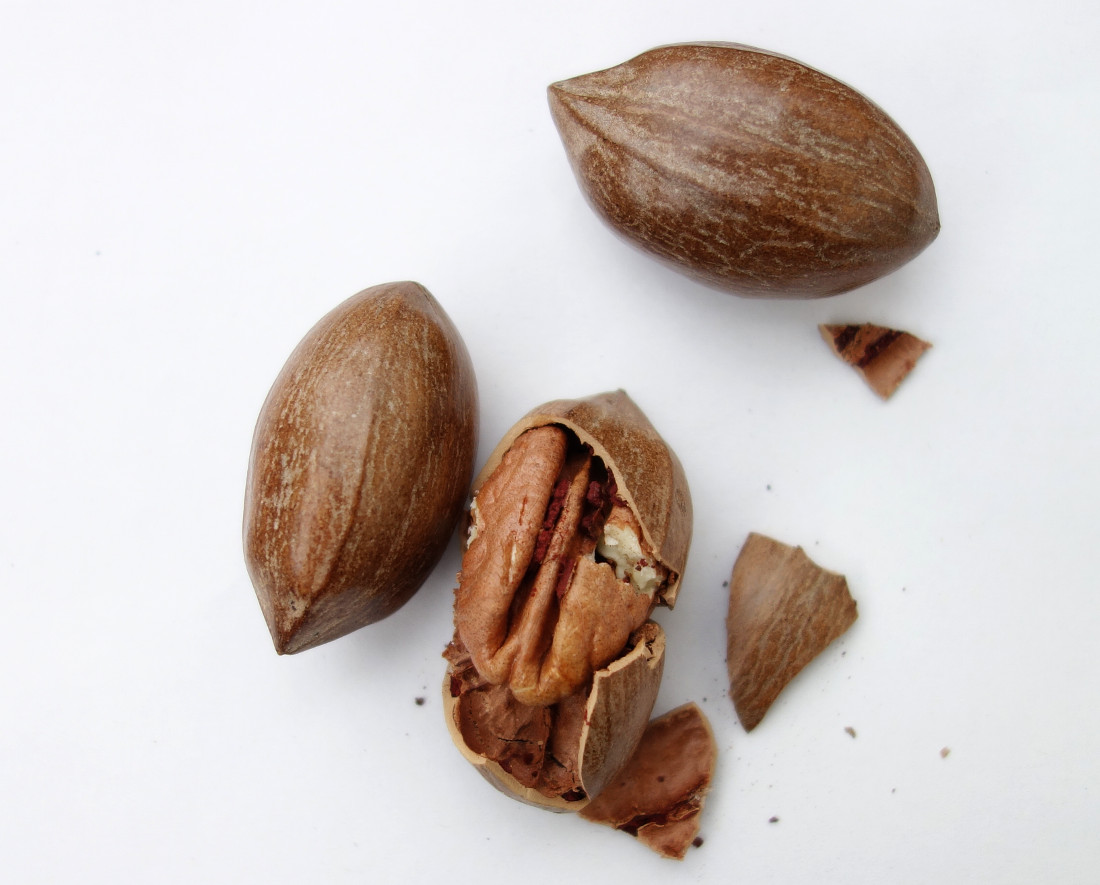Carya illinoinensis (Wangenh.) K. Koch - Syn.Carya illinoensis (Wangenh.) K. Koch; Hicorius pecan (Marshall) Britton; Carya pecan (Marshall) Engl. & Graebn. - Juglandaceae - pecan, Pekannuss, Hickorynuss (-baum)
Tree, native to Northern America, cultivated elswhere for its edible nuts; leaves compound, up to 35cm long, leaflets usually 9-13, elliptic-lanceolate, glabrous or glabrescent; male spikes up to 14 cm long; nuts ovoid-ellipsoid, 3-5×2-3cm, husk without prominent wings.
http://www.efloras.org/florataxon.aspx?flora_id=2&taxon_id=210000185
„A pecan, like the fruit of all other members of the hickory genus, is not truly a nut, but is technically a drupe, a fruit with a single stone or pit, surrounded by a husk…
The seeds of the pecan are edible, with a rich, buttery flavor. They can be eaten fresh or used in cooking, particularly in sweet desserts.“
http://en.m.wikipedia.org/wiki/Pecan
The volatile compounds whose concentrations increased the most during storage of pecan nuts were identified as hexanal, dodecane, tridecane, and tetradecane.
[Correlation of objective and subjective measurements of pecan kernel quality., Forbus, W.R., Senter, S.D., Lyon, B.G., Dupuy, H.P., Journal of Food Science, Vol.45(5), 1980, 1376-1379]
Pecan seeds show high amounts of lipid (55-75%), thus the majotity of the volatiles identified are breakdown products of unsaturated fatty acids. Pecan seed oils contain alkanes (C5-C14), aldehydes (C2, C4-C10), ketones like acetone and 2-heptanone, and aromatic compounds like toluene, propylbenzene, benzaldehyde, and acetophenone.
[Flavor and Volatile Compounds in Tree Nuts, Cadwallader, K.R., Puangpraphant, S., in Tree Nuts: Composition, Phytochemicals, and Health Effects, C. Alasalvar, & F. Shahidi (Eds.). CRC Press: Boca Raton, FL., 2009, 109-126]
„Volatile components formed during the roasting of pecan kernels originate mainly via lipid oxidation/degradation and Maillard/Strecker reactions. Of particular importance to the sweet and nutty aroma of roasted pecans are 2-acetyl-1-pyrroline, 2-propionyl-1-pyrroline, 4-hydroxy-2,5-dimethyl-3(2H)-furanone, 3-methylbutanal, 3-ethyl-2,5- dimethylpyrazine, 2-ethyl-3,5-dimethyl-pyrazine, 2,3-diethyl-5-methylpyrazine, 2-pentylpyridine, and 2-acetyltetrahydropyridine.“
[in the aroma components of pecans during roasting., Cadwallader, K., Kim, H., Puangpraphant, S., Lorjaroenphon, Y., W: Expression of multidisciplinary flavor science., Red. I. Blank, M. Wüst, C. Yeretzian. Zürcher Hochschule für Angewandte Wissenschaften, Winterthur, Schweiz, 2010, 301-304] https://home.zhaw.ch/yere/pdf/Teil77%20-%20Expression%20of%20Multidisciplinary.pdf
Whereas cashew nut, hazelnut, almond, and Brazil nut samples had lower amounts in combination with sotolon/(2E,4E,6Z)-nona-2,4,6-trienal ratios clearly differing from 1:1 in walnuts, the pecan nut sample showed some walnut character in the aroma. Carya illinoinensis and Juglans regia belong to the same family Juglandaceae, so this is maybe not surprising. „Actually, the (2E,4E,6Z)-nona-2,4,6-trienal concentration in the pecan nuts with 7.87 μg/kg was almost as high as in the walnuts, where 10.2 μg/kg had been determined and the sotolon concentration with 23.6 μg/kg was even higher, resulting in a ratio of sotolon to (2E,4E,6Z)-nona-2,4,6-trienal of 3:1.“
[Stübner, Christine A., and Martin Steinhaus. „Sotolon and (2E,4E,6Z)-Nona-2,4,6-trienal Are the Key Compounds in the Aroma of Walnuts.“ Journal of Agricultural and Food Chemistry 71.18 (2023): 7099-7108]

Sargent, C.S., The Silva of North America, vol.7, t.339 (1898) [C.E.Faxon]
http://plantgenera.org/species.php?id_species=207477

Pecan seeds, CC BY-SA 3.0, Author: Andreas Kraska
